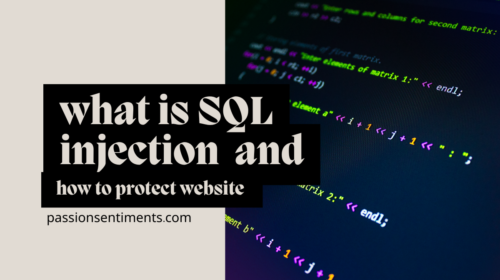SQL Injection (SQLi) is one of the most dangerous web security threats that allows attackers to manipulate a website’s database by injecting malicious SQL queries. If not properly mitigated, SQL injection can lead to data leaks, unauthorized access, and even complete database compromise.
In this article, we’ll explore how SQL injection works, different types of SQL injection attacks, and best practices to protect your website from such vulnerabilities.
Understanding SQL Injection
SQL Injection occurs when a hacker inserts malicious SQL queries into an input field of a web application to gain unauthorized access or manipulate the database. This happens when user inputs are directly included in SQL queries without proper sensitization.
For example, an insecure login query might look like this:
SELECT * FROM users WHERE username = '" + user_input + "' AND password = '" + pass_input + "'";
If an attacker enters:
OR 1=1 --
The query becomes:
SELECT * FROM users WHERE username = '' OR 1=1 --' AND password = ''
Since 1=1 is always true, the attacker gains access without valid credentials.
Types of SQL Injection Attacks
1 Error-Based SQL Injection
Attackers force the database to return error messages containing sensitive information, such as table names and database structure.
2 Union-Based SQL Injection
Hackers use the UNION operator to combine results from different tables and extract sensitive information.
3 Blind SQL Injection
The attacker does not receive direct feedback from the database but can infer information through Boolean conditions.
4 Time-Based SQL Injection
This technique makes the database execute time-delayed queries (SLEEP()). If the response is delayed, the attacker confirms a vulnerability.
Common SQL Injection Entry Points
SQL Injection can occur in various parts of a web application, including:
✅ Login forms
✅ Search bars
✅ Contact forms
✅ URL parameters (GET requests)
✅ Cookies
✅ Admin dashboards
Best Practices to Prevent SQL Injection
Use Prepared Statements and Parameterized Queries
Instead of embedding user input directly into SQL queries, use prepared statements with parameterized queries. This ensures user input is treated as data, not code.
Example: Secure Login Query (PHP with MySQLi)
$stmt = $conn->prepare("SELECT * FROM users WHERE username = ? AND password = ?");
$stmt->bind_param("ss", $username, $password);
$stmt->execute();
This approach prevents attackers from injecting malicious SQL code.
Implement Web Application Firewalls (WAF)
A WAF helps block known SQL injection patterns before they reach your application. Some popular WAFs include:
✅ Cloudflare WAF
✅ ModSecurity
✅ Sucuri Firewall
Limit Database Privileges
Always follow the Principle of Least Privilege (PoLP):
❌ Do not use the root/admin account for database connections.
✅ Create dedicated read-only and write-specific accounts with minimal privileges.
Example: Restricting Privileges (MySQL)
GRANT SELECT, INSERT ON mydatabase.* TO 'user'@'localhost';
This prevents unauthorized table deletion, updates, or access.
Validate and Sanitize User Inputs
Never trust user input! Always validate and sanitize data before executing SQL queries.
✅ Examples of Input Validation
- Allow only specific characters in username fields (e.g.,
A-Z,a-z,0-9). - Restrict email format using regex.
- Reject SQL-specific keywords like “SELECT”, “DROP”, “UNION”.
Example: Sanitizing User Input (Python Flask)
import re
def sanitize_input(user_input):
return re.sub(r"[^a-zA-Z0-9]", "", user_input) # Removes special characters
Use Stored Procedures
Stored procedures execute predefined SQL queries and do not allow dynamic query building.
Example: Stored Procedure for Secure Login (MySQL)
CREATE PROCEDURE GetUser(IN username VARCHAR(255))
BEGIN
SELECT * FROM users WHERE username = username;
END;
Hide Error Messages
Do not display detailed database error messages to users, as they reveal database structure.
✅ Show generic error messages:
die("Invalid credentials. Please try again.");
❌ Avoid displaying MySQL errors like:
die(mysqli_error($conn));
Regularly Update Software and Database Systems
- Update your CMS, frameworks, and plugins to patch known vulnerabilities.
- Use the latest versions of MySQL, PostgreSQL, or MongoDB with security patches.
Deploy Intrusion Detection Systems (IDS)
An IDS helps monitor SQL injection attempts in real-time. Some popular IDS tools include:
- Snort
- OSSEC
- Fail2Ban
6. Testing for SQL Injection Vulnerabilities
To ensure your website is secure, regularly test for SQL injection using tools like:
| Tool Name | Type | Purpose |
|---|---|---|
| SQLmap | Automated SQLi Testing | Finds and exploits SQL injection vulnerabilities |
| Burp Suite | Web Security Scanner | Detects SQLi and other web security threats |
| OWASP ZAP | Security Testing Tool | Identifies SQL injection, XSS, and security flaws |
Manual Testing Tip:
Try entering ' OR 1=1 -- in login fields to check if your website is vulnerable.
7. Conclusion
SQL Injection is a serious threat that can compromise databases, expose sensitive user information, and even take down entire applications. However, by implementing best security practices such as prepared statements, input validation, least privilege access, and web application firewalls, you can effectively prevent SQL injection attacks.
Securing your website is an ongoing process, and regular security audits, penetration testing, and software updates are critical in maintaining protection. Stay proactive, keep learning about emerging threats, and ensure your website remains safe from SQL injection and other cyber attack



